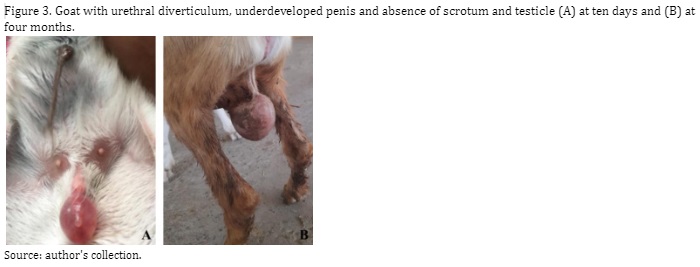Clinical and surgical aspects of hypospadia and urethral diverticulum in goats
DOI:
https://doi.org/10.21708/avb.2023.17.2.11358Resumo
Hypospadia is the imperfect closure of the external urethra of the male which results from the incomplete fusion of the urogenital folds and abnormal openings of the penile urethra. The urethral diverticulum is the abnormal dilatation of the urethra, and can be of multifactorial origin and related to genetic, endocrinological and environmental factors. The objective of this article is to report on the clinical and surgical treatment of two cases of hypospadias and one case of urethral diverticulum in goats raised as pets, originated from cross breeding polled pairs. In Case 1 the hypospadias was characterized by two orifices on the ventral portion of the penis, separated by a 2 cm interruption of the urethra, and in Case 2 by an orifice on the ventral portion in the region of the urethra. In both cases there was an accumulation of urine in the middle ventral region of the foreskin, leading to distension of the skin. Both cases were successfully treated by urethrostomy and partial penectomy with fixation of the proximal urethral ostium to the skin. In Case 3, the animal was seen at ten days of age with presence of a diverticulum in the preputial region, however, the animal returned for new care only after four months due to urethral obstruction and died as a result of advanced azotemia. Surgical treatment of hypospadia, when performed before the development of azotemia associated with urinary retention, has been shown to be efficient, and post-operative care is important.
Downloads

Downloads
Publicado
Edição
Seção
Licença
Copyright (c) 2023 Acta Veterinaria Brasilica

Este trabalho está licenciado sob uma licença Creative Commons Attribution 4.0 International License.
Autores que publicam na Acta Veterinaria Brasilica concordam com os seguintes termos: a) Autores mantém os direitos autorais e concedem à revista o direito de primeira publicação, com o trabalho simultaneamente licenciado sob a Licença Creative Commons Attribution que permite o compartilhamento do trabalho com reconhecimento da autoria e publicação inicial nesta revista. b) Autores têm autorização para assumir contratos adicionais separadamente, para distribuição não-exclusiva da versão do trabalho publicada nesta revista (ex.: publicar em repositório institucional ou como capítulo de livro), com reconhecimento de autoria e publicação inicial nesta revista. c) Autores têm permissão e são estimulados a publicar e distribuir seu trabalho online (ex.: em repositórios institucionais ou na sua página pessoal) a qualquer ponto antes ou durante o processo editorial, já que isso pode gerar alterações produtivas, bem como aumentar o impacto e a citação do trabalho publicado (Veja O Efeito do Acesso Livre).


 Esta obra está licenciada com uma Licença
Esta obra está licenciada com uma Licença 